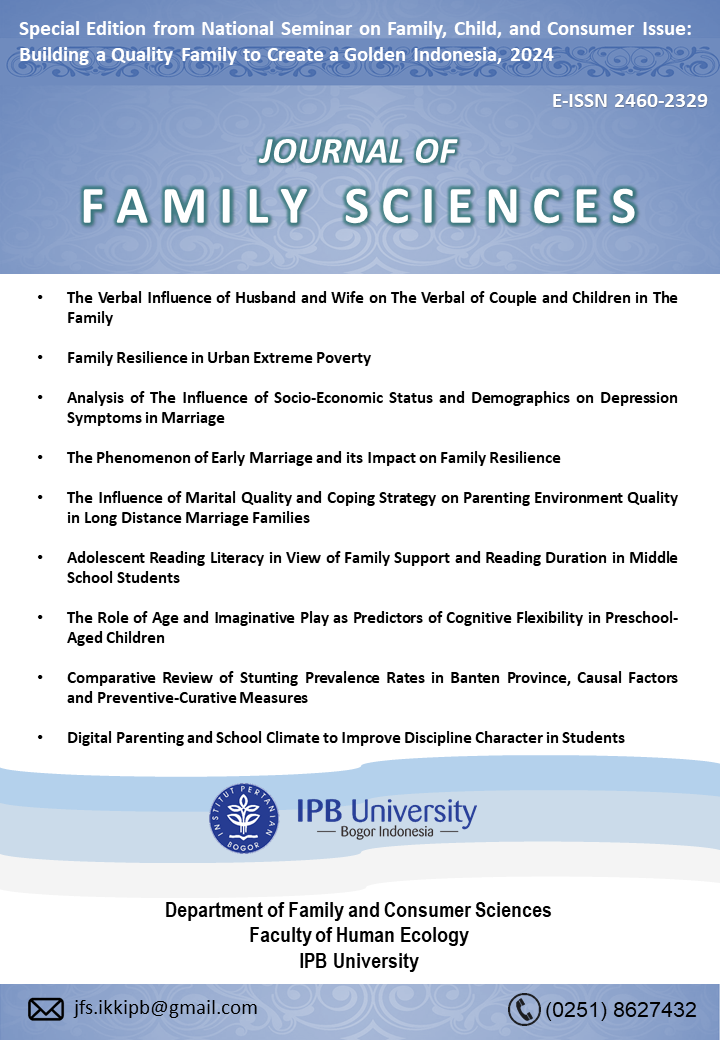Comparative Review of Stunting Prevalence Rates in Banten Province, Causal Factors and Preventive-Curative Measures
Abstract
This research is important because it has a novel to stunting intervention through a family approach. The research also answers previous researchers' expectations regarding the scarcity of research on stunting with a family approach. This research is a cross-sectional study conducted in March-May 2023 using secondary data processed from the 2021 Family Data Collection (PK21) data which is then carried out with a descriptive analysis. Banten Province has a number of families at risk of stunting, one-third of the total families in the province. Namely, 2,658,505 families were recorded and 885,301 families at risk of stunting. In sequence the number of families at risk of stunting in regencies and cities in Banten Province from the largest to the smallest is Cilegon City 219,973 families, Serang City 143,187 families, Tangerang City 118,273 families, South Tangerang City 126,800 families, Pandeglang Regency 115,807 families, Lebak Regency 74,313 families, Serang District 52,204 families and Tangerang District 43,744 families. This study concludes that Serang City, South Tangerang City and Pandeglang Regency are 3 districts/cities that have data on families at risk of stunting exceeding families that are not at risk of stunting in these districts/cities. Lebak, Pandeglang and Serang Regencies which border the Indian Ocean have the dominant factor causing stunting from the sanitation aspect. This study concluded that three times the number of family assistance staff from families at risk of stunting is needed in the context of stunting eradication and stunting prevention in the future.
Downloads
References
Andarini A. S., Indrawan, I. W. A., & Ariani. (2022). Stunting incidence determinants in toddlers (24–59 months) born to early married mothers. Pakistan Journal of Medical & Health Sciences, 16 (5), 1381-1384. https://doi.org/10.53350/pjmhs221651381
Audah, K. A., Alfiandri, A., Pandiangan, F. I., Sushanty, V. M., & Legowo, E. H. (2019). Penyediaan dan pemeliharaan fasilitas air bersih dan sanitasi untuk peningkatkan kualitas hidup masyarakat di Desa Binaan. Prosiding PKM-CSR, 2, 516-522. https://doi.org/10.37695/pkmcsr.v2i0.462
Barai, S. A., Nurmahfuzhah, N., & Defina. (2023). Cultivating Sustainability: Exploring the Relationship between Homestead Gardening, Land Property, and Family Economic Pressure in Household with Stunting Children. Journal of Family Sciences, 8 (2): 190-203. https://doi.org/10.29244/jfs.v8i2.51324
Beal, T., Tumilowicz, A., Sutrisna, A., Izwardy, D., & Neufeld, L. M. (2018). Review Article: A review of child stunting determinants in Indonesia. Wiley: Maternal and Child Nutrition, 1-10. https://doi.org/10.1111/mcn.12617
[BKKBN] Badan Kependudukan dan Keluarga Berencana Nasional. 2022. Panduan Bapak Asuh Anak Stunting. Jakarta (ID): BKKBN.
[BKKBN] Badan Kependudukan dan Keluarga Berencana Nasional. 2021. Panduan Pelaksanaan Pendampingan Keluarga dalam Upaya Percepatan Penurunan Stunting di Tingkat Desa/Kelurahan. Jakarta (ID): BKKBN.
Cahyadi, N., Hanna, R., Olken, B. A., Prima, R. A., Satriawan, E., & Syamsulhakim, E. (2018). Cumulative impacts of conditional cash transfer programs: working paper 4 – 2018 experimental evidence from Indonesia. TP2K dan Pemerintah Australia.
Dorsey, J. L., Manohar, S., Neupane, S., Shrestha, B., Klemm, R. D. W., & West, K. P. (2016). Individual, household, and Community level risk factor of stunting in Children younger than 5 years: Finding from a national surveillance system in Nepal. WILEY: Maternal & Child Nutrition, 2018 (14) 1-16. https://doi.org/10.1111/mcn.12434
Fatmaningrum, W., & Nadhiroh, S. R. (2022) Analisis Situasi Upaya Percepatan Penurunan Stunting Dengan Pendekatan Keluarga Berisiko Stunting (Studi Kasus di Kabupaten Jombang Jawa Timur). Media Gizi Indonesia (National Nutrition Journal), 1, 139–144. https://doi.org/10.20473/mgi.v17i1SP.139–144
Hermawan, N. S. A., Umar, M. Y., & Agustriyani F. (2023). Environmental and family approach on stunting: a literature review. Jurnal Aisyah: Jurnal Ilmu Kesehatan, 8 (S1), 303-308. https://doi.org/10.30604/jika.v8iS1.1720
Ibrahim, I., Sartika, A. D. S., Triyanti, & Permatasari, T. A. E. (2021). Faktor-faktor yang berhubungan dengan kejadian diare pada siswa sekolah dasar di Kabupaten Lebak, Provinsi Banten, Indonesia. Indonesian Journal of Public Health Nutrition (IJPHN), 2(1), 34 – 43. http://dx.doi.org/10.7454/ijphn.v2i1.5338
Kementrian/Lembaga Pelaksana Program/Kegiatan Pencegahan Anak Kerdil (Stunting). (2018.) Strategi Nasional Percepatan Pencegahan Anak Kerdil (Stunting) Periode 2018-2024. Kementrian Dalam Negeri. TNP2K.
Khusna, N. A., & Nuryanto. (2017). Hubungan usia ibu menikah dini dengan status gizi batita di Kabupaten Temanggung. Journal of Nutrition College, 6 (1), 1-10. https://doi.org/10.14710/jnc.v6i1.16885
Khairunnisa., & Yuniarti, K. (2020). Relationship Age on Married Adolescents with Stunting Categories. Jurnal Darul Azhar, 9 (1), 40-48.
Kobayashia, Y., Itoa, Y., Shresthab. S., Yokomichid, H., & Nishidae, K. (2022). Relationship between diarrhoea risk and the combinations of drinking water sources in the Kathmandu Valley, Nepal. International Healt, 12 (2), 195-200. https://doi.org/10.1093/inthealth/ihab032
Leroy, J. L., Olney, D. K., Ruel, M., Covic, N., & Hendriks, S. L. (2015). Evaluating nutrition-sensitive programs: challenges, methods, and opportunities. ROSAKSS Annual Trends and Outlook Report, 131-146.
Mariana, P. P., & Lestari, K. S. (2022). Analysis of personal hygiene and access to sanitation factors on stunting cases toddlers in asia: literature review. Promotive: Journal of Public Health, 12 (2), 116-120. https://doi.org/10.56338/promotif.v12i2.2661
Nursalamah, M., Giyanto, B., & Sutrisno, E. (2021). Analisis implementasi gerakan masyarakat hidup sehat (GERMAS) di Kabupaten Lebak. Jurnal Pembangunan dan Administrasi Publik, 3 (2), 9-22. https://doi.org/10.32834/jpap.v3i2.407
Putri, A. R. (2020). Aspek pola asuh, pola makan, dan pendapatan keluarga pada kejadian stunting. Healthy Tadulako Journal, 6(1), 1-72.
Rahmawati, E., & Kisworo, B. (2017). Peran pendamping dalam pemberdayaan masyarakat miskin melalui program keluarga harapan. Journal of Nonformal Education and Community Empowerment, 1(2), 161-169. https://doi.org/10.15294/jnece.v1i2.16271
Raikhani, A., Masluchah, L., Fatmaningrum, W., Patmawati., Utomo, B., & Jannah, A.Z. (2022). Implementasi dana desa sebagai upaya intervensi penurunan stunting Desa Pandan Wangi Kecamatan Diwek Kabupaten Jombang. Media Gizi Indonesia (National Nutrition Journal), 1, 250–256. https://doi.org/10.20473/mgi.v17i1SP.
Rosha, B. C., Sari, K., Yunita, S. P. I., Amaliah, N., & Utami, N. H. (2016). Peran Intervensi Gizi Spesifik dan Sensitif dalam Perbaikan Masalah Gizi Balita di Kota Bogor. Buletin Penelitian Kesehatan, 44 (2): 127 – 138.
Riu, S. D. M., & Bunsal, C. M. (2022). Evaluasi data balita stunting dan pencanangan pot ashanti (program orang tua asuh anak stunting). Jurnal Pengabdian kepada Masyarakat Nusantara (JPkMN), 3 (1), 418-422.
Siswati, T. (2018). Stunting. Yogyakarta (ID): Husada Mandiri.
Setiawan, E., & Machsus. S. (2023). The role of social and economic dimensions of the family in preventing and reducing stunting in Bekasi district. Journal of Family Science, 66-79. https://doi.org/10.29244/jfs.vi
Widasari, L., Elda, F., Sudarno, R., Puridawati, B., Battung, S, M., & Soewondo P. (2023). Stunting Pedia, Jilid 1. Jakarta (ID): Kepustakaan Populer Gramedia, Tanoto Foundation.
Widiastuti, A. (2019). Pengelolaan sanitasi lingkungan dalam pembangunan daerah di Kota Serang. Jurnal Ekonomi-Qu, 9(2), 178-199. http://dx.doi.org/10.35448/jequ.v2i2.7166
Yuningsih, R. (2019). Strategi promosi kesehatan dalam meningkatkan kualitas sanitasi lingkungan. Aspirasi: Jurnal Masalah-Masalah Sosial, 10(2), 107-118. https://doi.org/10.22212/aspirasi.v10i2.1391
Copyright (c) 2024 Journal of Family Sciences

This work is licensed under a Creative Commons Attribution 4.0 International License.
Authors who publish with this journal agree to the following terms:
- Authors retain copyright and grant the journal right of first publication with the work simultaneously licensed under

This work is licensed under a Creative Commons Attribution 4.0 International License. that allows others to share the work with an acknowledgement of the work's authorship and initial publication in this journal. - Authors are able to enter into separate, additional contractual arrangements for the non-exclusive distribution of the journal's published version of the work (e.g., post it to an institutional repository or publish it in a book), with an acknowledgement of its initial publication in this journal.
- Authors are permitted and encouraged to post their work online (e.g., in institutional repositories or on their website) prior to and during the submission process, as it can lead to productive exchanges, as well as earlier and greater citation of published work (See The Effect of Open Access).



_001.png)



